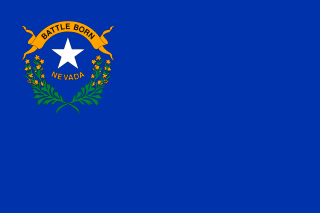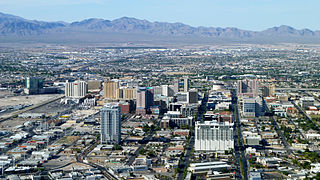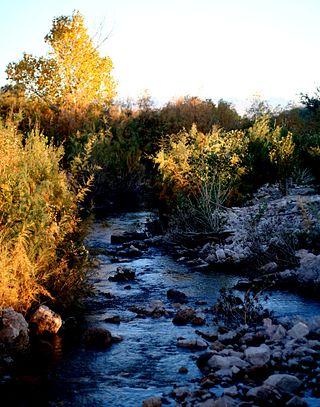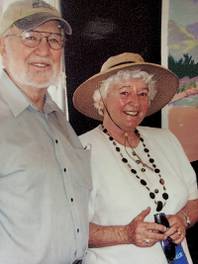
Nevada is a state in the Western region of the United States. It is bordered by Oregon to the northwest, Idaho to the northeast, California to the west, Arizona to the southeast, and Utah to the east. Nevada is the 7th-most extensive, the 32nd-most populous, and the 9th-least densely populated of the U.S. states. Nearly three-quarters of Nevada's people live in Clark County, which contains the Las Vegas–Paradise metropolitan area, including three of the state's four largest incorporated cities. Nevada's capital is Carson City. Las Vegas is the largest city in the state.

Las Vegas, often known simply as Vegas, is the 25th-most populous city in the United States, the most populous city in the state of Nevada, and the county seat of Clark County. The Las Vegas Valley metropolitan area is the largest within the greater Mojave Desert, and 2nd-largest in the Southwestern United States. Las Vegas is an internationally renowned major resort city, known primarily for its gambling, shopping, fine dining, entertainment, and nightlife. The Las Vegas Valley as a whole serves as the leading financial, commercial, and cultural center for Nevada.

Clark County is a county located in the U.S. state of Nevada. As of the 2020 census, the population was 2,265,461. Most of the county population resides in the Las Vegas Census County Divisions, which hold 2,196,623 people as of the 2020 Census, across 435 square miles (1,130 km2). It is by far the most populous county in Nevada, and the 11th most populous county in the United States. It covers 7% of the state's land area but holds 73% of the state's population, making Nevada the most centralized state in the United States.

Enterprise is an unincorporated town in the Las Vegas Valley in Clark County, Nevada, United States. The population was 221,831 at the 2020 U.S. census, up from 14,676 at the 2000 census. It was founded on December 17, 1996. Like other unincorporated towns in the Las Vegas Valley, it uses Las Vegas ZIP codes for addresses within its boundaries.

Laughlin is an unincorporated community in Clark County, Nevada, United States. Laughlin lies 90 miles (140 km) south of Las Vegas, in the far southern tip of Nevada. As a resort town, it is known for its gaming and water recreation. As of the 2020 census, the population was 8,658. For statistical purposes, the United States Census Bureau has defined Laughlin as a census-designated place (CDP). It is located on the Colorado River, downstream from the Davis Dam and Lake Mohave, and directly across from the much larger Bullhead City, Arizona. The nearby communities of Bullhead City, Arizona; Needles, California; Fort Mohave, Arizona; and Mohave Valley, Arizona, bring the area's total population to about 100,000. Laughlin is also 286 miles (460 km) northeast of Los Angeles.

Winchester is an unincorporated town and census-designated place (CDP) in Clark County, Nevada, United States that contains part of the Las Vegas Strip. It is one of a number of CDPs in the unincorporated urbanized area directly south of Las Vegas. The population was 36,403 at the 2020 census. It is governed by the Clark County Commission with advice from the Winchester Town Advisory Board. "Winchester, NV" does not appear in postal addresses; the United States Postal Service has assigned "Las Vegas, NV" as the place name for the ZIP codes containing Winchester.

The Las Vegas Valley is a major metropolitan area in the southern part of the U.S. state of Nevada, and the second largest in the Southwestern United States. The state's largest urban agglomeration, the Las Vegas Metropolitan Statistical Area is coextensive since 2003 with Clark County, Nevada. The Valley is largely defined by the Las Vegas Valley landform, a 600 sq mi (1,600 km2) basin area surrounded by mountains to the north, south, east and west of the metropolitan area. The Valley is home to the three largest incorporated cities in Nevada: Las Vegas, Henderson and North Las Vegas. Eleven unincorporated towns governed by the Clark County government are part of the Las Vegas Township and constitute the largest community in the state of Nevada.

The Southern Nevada Water Authority (SNWA) is a government agency that was founded in 1991 to manage Southern Nevada's water needs on a regional basis in Clark County.

The Las Vegas Metropolitan Police Department is a combined city and county law enforcement agency for the City of Las Vegas and Clark County, Nevada, United States. It is headed by the Sheriff of Clark County, who is publicly elected every four years. The sheriff is the only elected head law enforcement officer within the county, and, as such, the department is not under the direct control of its jurisdictional cities, Clark County, or the State of Nevada.

The Muddy River, formerly known as the Moapa River, is a short river located in Clark County, in southern Nevada, United States. It is in the Mojave Desert, approximately 60 miles (97 km) north of Las Vegas.
The Clark County Water Reclamation District (District) is a government wastewater treatment agency in Clark County, Nevada. As a member of the Southern Nevada Water Authority, its mission is to treat millions of gallons of wastewater that is produced every day. The District is the largest water treatment agency in Southern Nevada and is responsible for treating wastewater from unincorporated parts of Clark County within the Las Vegas Valley, including most of the Las Vegas Strip, and the communities of Blue Diamond, Moapa Valley, Indian Springs, Laughlin, and Searchlight.
The settlement of Las Vegas, Nevada was founded in 1905 after the opening of a railroad that linked Los Angeles and Salt Lake City. The stopover attracted some farmers to the area, and fresh water was piped in to the settlement. In 1911, the town was incorporated as part of the newly founded Clark County. Urbanization took off in 1931 when work started on the Boulder Dam, bringing a huge influx of young male workers, for whom theaters and casinos were built, largely by the Mafia. Electricity from the dam also enabled the building of many new hotels along the Strip. The arrival of Howard Hughes in 1966 did much to offset mob influence and helped turn Las Vegas into more of a family tourist center, now classified as a Mega resort.

The Tonopah and Tidewater Railroad was a former class II railroad that served eastern California and southwestern Nevada.

Coyote Springs, Nevada, is a master-planned community being developed in Lincoln County and Clark County, Nevada. The community was initially planned by developer and attorney-lobbyist Harvey Whittemore and Pardee Homes. Thomas Seeno and Albert Seeno, Jr. became the sole owners of Coyote Springs following Whittemore's resignation from the Wingfield Nevada Holding Group amidst legal troubles. No homes had been built as of June 2018.
The Clark County Commission is the governmental organization that governs and runs Clark County, Nevada, providing services to the unincorporated areas. Its offices are located at the Clark County Government Center in Downtown Las Vegas. The commission is considered by many to be the most powerful governmental body in the state of Nevada.
Decatur Boulevard is a major north–south section line arterial in the Las Vegas metropolitan area located on the west side of the city.

Elizabeth von Till Warren was an American historian and preservationist. She had expertise in the history of water development in the Mojave Desert and the Las Vegas Valley in particular. She also had expertise in the historical route of the Old Spanish Trail in Southern Nevada.

Molasky Corporate Center is a 17-story office and retail building in downtown Las Vegas, Nevada. The building was developed by Irwin Molasky's company, The Molasky Group. Construction began in 2005, and the building was topped off in July 2006, before opening in August 2007. The Molasky Corporate Center is a green building designed with energy efficient features which earned it a Gold certification from the Leadership in Energy and Environmental Design (LEED). The Southern Nevada Water Authority is a major tenant in the building, and owns five of the building's office floors.
















